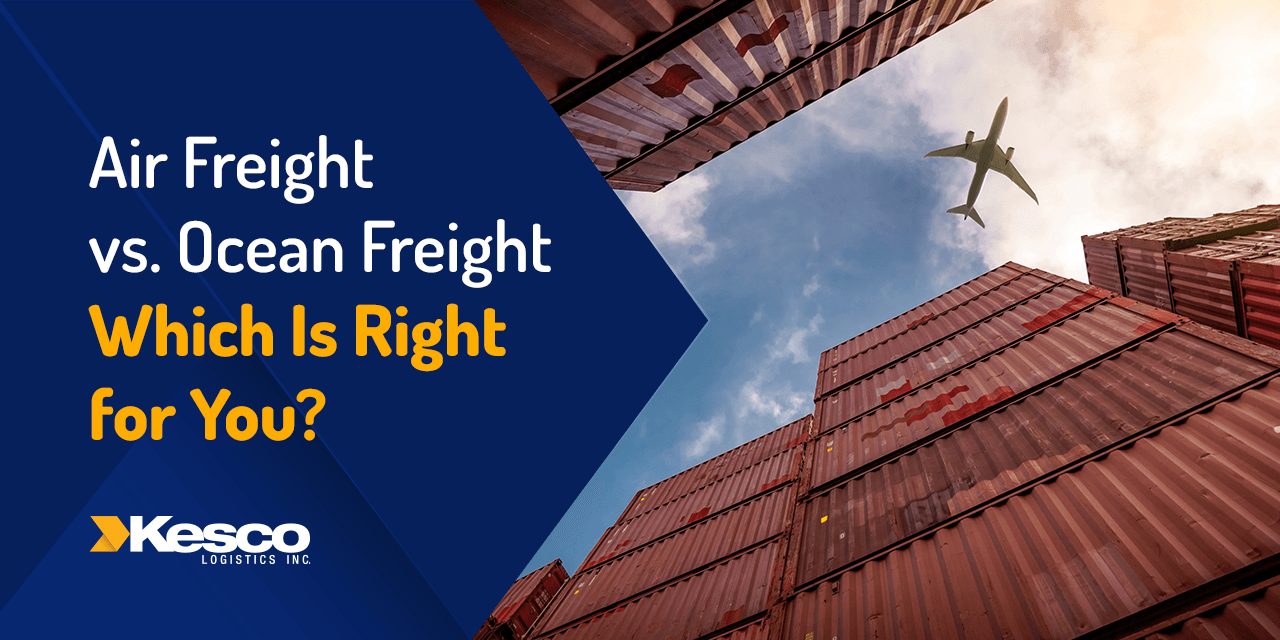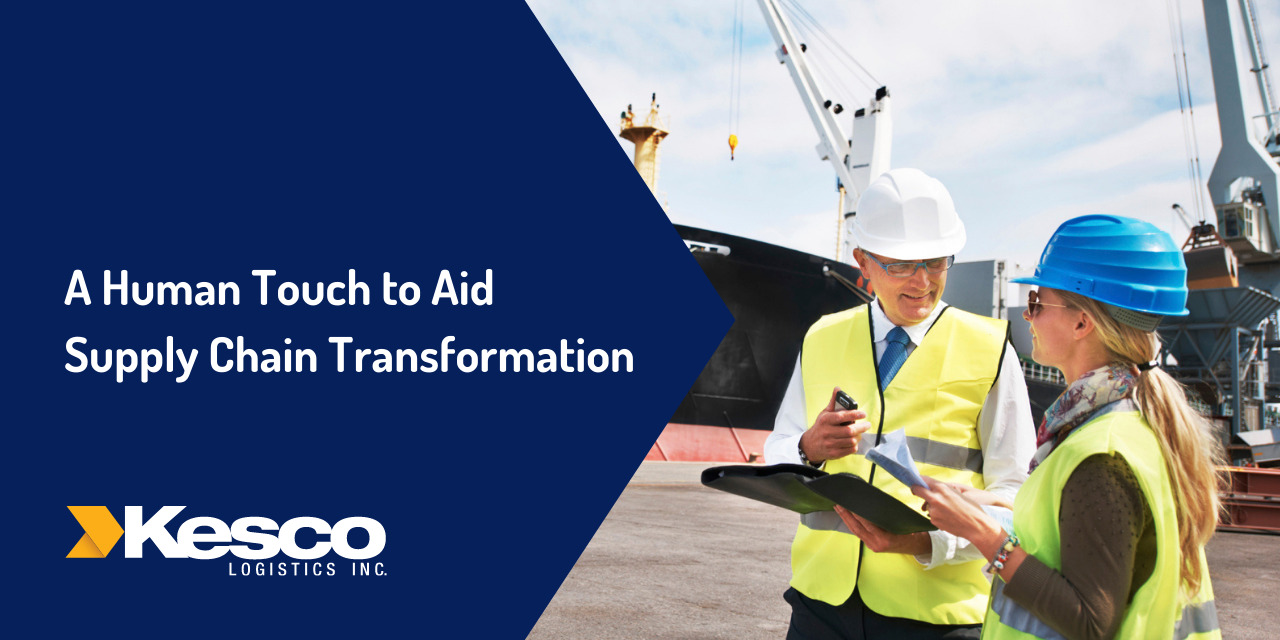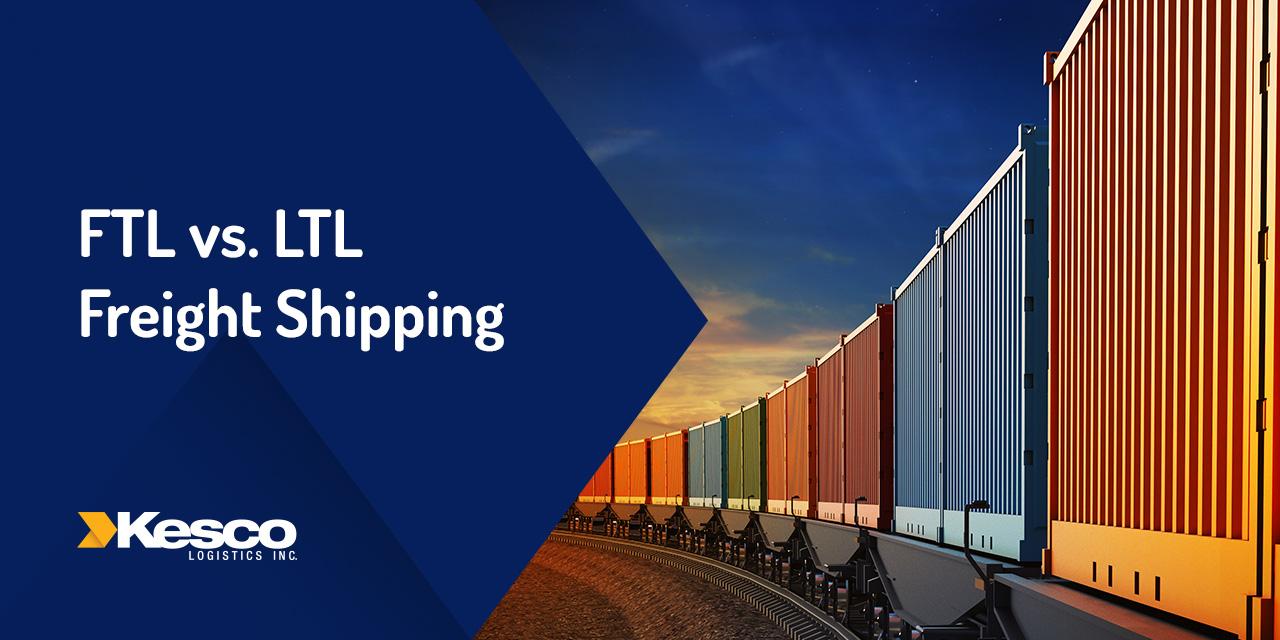Air Freight | Ocean Freight | Choosing Air vs. Ocean Freight | Organize Your Shipment Method With Kesco Logistics
In our increasingly globalized economy, finding the best way to get products overseas is a key part of your business. It impacts your reputation, product condition, carbon footprint and, of course, your finances. Whether by air or by sea, product freight needs will vary by product and business needs.
So, how do you know whether air freight or ocean freight is best for your organization? Let’s weigh some air and ocean freight pros and cons to help you decide.
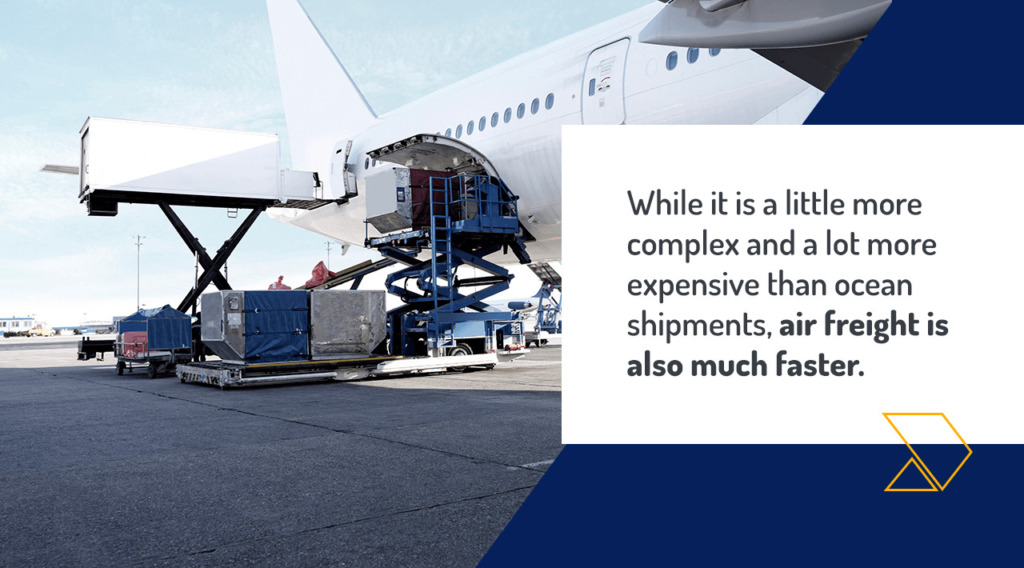
Air Freight
While it is a little more complex and a lot more expensive than ocean shipments, air freight is also much faster. Products can cross the sea in as little as a few days. It’s necessary for many perishable goods that need to be sold before they expire, like produce. Air freight is also suitable for temperature-sensitive products, like pharmaceuticals, though temperature-controlled ocean freight is available.
Even if the product doesn’t require this mode of transit, many e-commerce providers opt for the faster shipment option to stay competitive. It means they can get products overseas in days rather than weeks.
Some air cargo benefits include:
- Speed: One of the primary pros of air cargo is its much faster transit time. It’s a competitive advantage for many shippers and a necessity for others.
- Better security: Shipping via plane can deliver stronger security for your products. Air shipments are strictly regulated, moving through the high-security environment of airports. For high-value items, this can be a significant benefit.
- Reliability: Air shipments can be more reliable since airlines operate on strict, well-organized schedules. Should there be a problem with a flight, many others are ready to take off soon to get your cargo to its destination.
Meanwhile, some cons of air freight include:
- Cost: Shipping cargo via plane is significantly more expensive than shipping by sea. For some, the advantages outweigh the cost. It really depends on the items being sent and your company’s position.
- Carbon footprint: Airplanes use up a lot of fossil fuel and create a considerable carbon footprint. If you’re looking to be as eco-friendly as possible, air freight isn’t going to be the best option. Sea shipments are generally more environmentally friendly. Some companies choose to offset their carbon footprint to make their shipping operations carbon neutral.
- Cargo types: Air freight must meet size and weight restrictions, as well as safety requirements. Not all items will be permitted or cost-effective to ship via plane.
Air freight can expose products to certain conditions, like vibration, static electricity and pressure that cause problems for sensitive items. Many dangerous goods cannot be shipped by air at all or need extra care. Examples of these items include:
- Gases, such as fire extinguishers, butane fuel, lighters, spray paints and aerosols.
- Flammable items, including some alcohols, paint, resins, matches, coal and bleach.
- Toxic items, like arsenic, pesticides, some medicines, blood samples and radioactive machinery.
- Corrosive items, such as certain batteries, drain cleaner and mercury thermometers.
- Other hazardous materials such as dry ice, lithium batteries, magnetized materials and engines.
If you’re unsure whether your product is considered dangerous, check the list of commonly shipped hazardous materials provided by the Federal Aviation Administration (FAA) or give us a call.
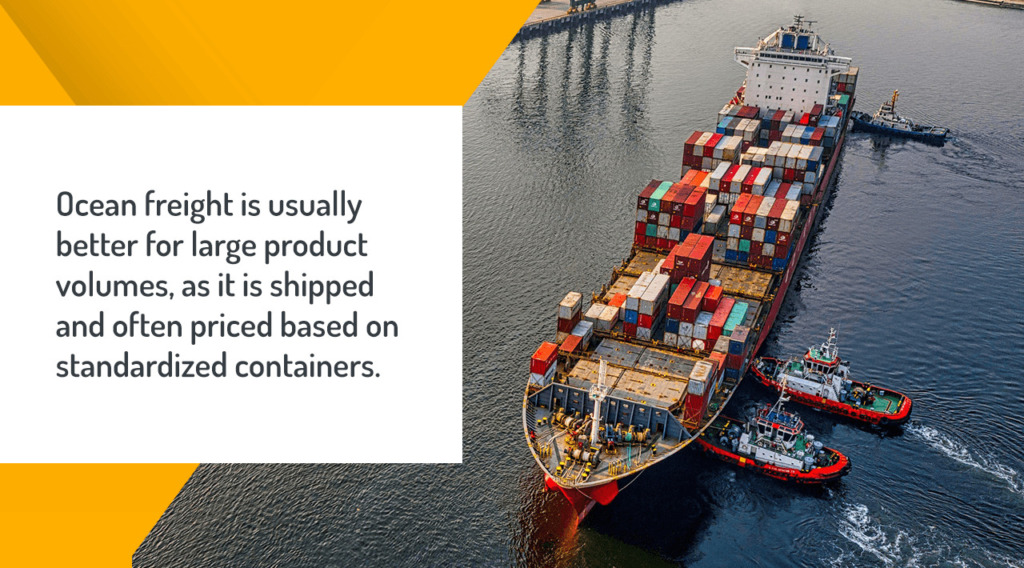
Ocean Freight
Ocean freight is usually better for large product volumes, as it is shipped and often priced based on standardized containers. Sea freight can take longer than air freight — though some methods come pretty close to air transit time, and it’s much less expensive. It’s a popular choice for e-commerce goods like electronics, apparel and home goods that don’t need much special care and are often sent in large quantities.
Traditionally, ocean freight takes about a month to arrive. Newer methods like express less-than-container load (LCL) services can bring that timeline down to just over a week. LCL shipping consolidates the products of multiple shippers into one container. It’s a faster approach than full-container loads (FCL) and comes pretty close to meeting air freight transit times.
While these services used to cost a premium and take more time, they’ve come a long way. More competition, faster ships and new canal routes have made express or expedited LCL a quick yet affordable option for many overseas shippers.
LCL and traditional ocean freight transport are often selected because their significantly reduced costs are often just a fraction of air freight. Still, it depends on the items being shipped and whether you’re sending enough to fill a container.
The pros of ocean freight include:
- Cost: One of the most advantageous sea cargo benefits is its low price point. Sea cargo is usually more affordable than air freight.
- Cargo versatility: Without the restrictions or weight limitations on aircraft, ocean shipments are great for heavy, large or oddly shaped items.
- Environmental friendliness: Ships are much easier on the planet than airplanes, so they can help companies maintain green practices.
The cons of sea cargo include:
- Speed: The major downside to ocean freight is the longer transit time. While LCL options can speed things up, air shipping still takes the lead in this category.
- Reliability: Another downside of sea freight is that it can be harder to predict and control. Ships aren’t as tightly organized as aircraft, so delays are more common, along with port congestion and potential customs issues.
- Less flexibility: Seaports often run on weekly schedules, as opposed to the daily movements of aircraft. If you have sudden shipment needs, such as for medical supplies or auto parts, you can’t send them off right away and may need to wait for the next vessel to leave.

Choosing Air vs. Ocean Freight
When comparing ocean and air freight, you’ll need to consider how each one would affect your business. Shipping costs aren’t the only consideration, and many shippers find that the benefits of air shipping can offset its higher price. Still, ocean freight provides the better value for some shippers. It comes down to finding the right balance between service quality, cost, reliability and other factors important to your business.
Below are some considerations for deciding between ocean and air freight for your products.
1. Cost
Cost is usually the first thing that shippers look at. Ocean freight is typically cheaper because airlines bill primarily by weight, while sea carriers charge by container. While weight can sometimes play a role in sea freight cost, carriers generally set prices by standard container sizes, such as 20-foot and 40-foot containers.
This pricing model means you can jam-pack a container and get a lot of value out of that space, even if your items are pretty heavy. Shipping by sea is usually the more cost-effective choice for large, heavy products. If your shipment is LCL, pricing is generally charged per cubic meter. The smaller the shipment, the smaller the margin becomes. Sometimes, this margin can get small enough that air freight becomes more cost-effective.
Both options will have some charges upon arrival, such as customs and destination fees. Seaports can be more expensive thanks to high warehousing fees. It’s also important to factor in the indirect monetary benefits that could come from faster, safer air freight service. For many, the value of fast shipping brings in more customers and can greatly improve the customer service experience. Since air travel is more reliable, you’ll be less likely to have your shipments get lost in transit, which saves you money replacing lost or damaged cargo.
2. Speed
Simply put, air freight is the faster option, which makes it worth the additional price for many shippers. While flights to almost any destination generally take less than a day, it takes some time to consolidate the cargo and get it all put together. Depending on your service provider, you may be looking at a day or two tacked onto departure and arrival dates for handling. Still, a few days is much faster than the few weeks you might see with ocean freight.
Sea shipments can take about a month to arrive, while express LCL freight can get onshore in as little as eight days. Both businesses and individuals want shipping as fast as possible. If you make fast shipping a selling point of your business, this speedy overseas delivery could be a useful, if not necessary, marketing tool. Many sellers, however, can work around month-long deliveries and save significantly on shipping costs. They might ship just enough to keep an onshore warehouse stocked, for instance.
In some cases, the longer transit time of sea freight can be desirable, such as when trying to time delivery with other events. Individuals, for example, might be moving the contents of their home overseas and would like some extra time to make arrangements before getting their items. It simply depends on your logistics.
Keep in mind that sea shipments can also come with congestion at port and additional costs such as demurrage and detention.
3. Reliability
Requiring precise delivery dates or having time for some wiggle room will determine what level of reliability you need. While weather delays are possible with air freight, airlines run like well-oiled machines. They stick to schedules pretty closely and have many flights at all times of the day, so they can usually get freight where it needs to go with minimal schedule changes.
Sea shipments, on the other hand, are known for being less organized. They might run a little off schedule and can take a few days to get back on track. If your cargo needs to arrive on a specific day, that type of delay can be troublesome. Remember that many seaports also run on weekly schedules, so if you have a shipment that misses a cutoff, there’s a much longer wait time until the next one, as opposed to the many flight options available for air freight.
Still, with carrier partnerships and ever-evolving technology, sea freight providers are building greater dependability. Some services, particularly LCL services, offer guaranteed delivery dates which can help reduce the risk associated with ocean freight. Tracking technology is also improving every day, so it’s getting easier to keep an eye on shipments and monitor them for delays.
4. Environmental Impact
If you’re trying to keep your carbon footprint low, ocean freight comes out on top.
One study found global aviation, both passenger and freight, responsible for 1.04 billion tonnes of carbon dioxide, about 2.5% of total carbon dioxide emissions. But its impact goes further than just carbon dioxide. Aircraft also release nitrous gases, water vapor, soot and other pollutants that can cause various problems for the environment, such as ozone formation and cirrostratus ice clouds.
While the sheer size of maritime shipping releases significant carbon dioxide, its carbon emissions per tonne-kilometer of goods are relatively low compared to road or air shipping. There is some debate about how ocean freight can contribute to oil spills and risks to ecosystems. Still, sea cargo is considered the more eco-friendly route in terms of carbon emissions and other pollutants.
If you’re trying to do your part for the environment and your delivery methods work well with ocean freight, it’s a great way to keep your carbon footprint down. As the world grows more environmentally conscious, minimizing the environmental impact of your shipping strategy can play a big role in keeping customers happy. It helps you position yourself as a company they feel good about buying from and allows you to do your part in the fight against climate change.
When shipping via either air or sea, many companies choose to use carbon offsetting investments to help them make their shipping efforts carbon neutral while still taking advantage of the methods that make sense for their business.
5. Cargo Type
Ocean freight is much more accommodating for large, oddly shaped or heavy items. The massive capacities of the containers make it easy to send these items without excessive costs. Flights are more limited. If your product is lightweight and easy to store, air freight might be the more practical choice. Consider what type of cargo you usually ship and how the two methods will vary.
6. Handling Requirements
Is your product sensitive, fragile or prone to damage? Both air and ocean freight have minimal cargo handling. On ships, you must pack your cargo tightly to avoid jostling around during transit. Meanwhile, airports provide strict security that can keep high-value items safer.
Remember, airports have extensive regulations, so if your product is combustible or poses some other risk, it might not be permitted on a plane. In those instances, you’ll need to take precautions before putting it on a boat, such as careful packaging and submitting the proper paperwork and warnings.
Organize Your Shipment Method With Kesco Logistics
Many factors come into play when it comes to deciding the best shipment method for your products. Fortunately, when you work with Kesco Logistics, you’re working with the experts. We have years of experience shipping across air and sea and can help you choose the right option for your organization. Our freight forwarding services are all about creating comprehensive end-to-end solutions for your supply chain and logistics needs.
With a range of partners and connections for ocean and air freight services, we can help you find a dependable, affordable and visible solution. Reach out to a Kesco Logistics team member today to start talking freight and determine which option is best for your business.

